Text
Francis Ford Coppola revived Victor Salva’s directing career after he was in prison for sexually abusing children, Harvey Weinstein is a sexual abusive creeper, Roman Polanski still can make movies that win awards after raping a young girl, Nickelodeon allowed a sex offender to work on children’s shows (Brian Peck) after he had been jailed for sex abuse on minors and Bryan Singer is closely connected with him, other known male sexual abusers still get to work in Hollywood, Cory Feldman claims that sex abusers surround children, Woody Allen makes tons of films despite being known as an abuser. Have I left anything out?
Hollywood is completely filled with creepers and this is making me rethink any young child actor or actress who ended up with alcohol and drug problems in their adult years.
39 notes
·
View notes
Quote
People argued a lot about “separating the art from the artist” when Woody Allen’s molestation of his daughter became impossible to ignore. However, here’s the thing: almost all of Woody Allen’s work is about a thinly guised version of him. A lot of it is about some old weird creep having a sexual relationship with a younger, beautiful woman under a clear imbalance of power. How the hell am I supposed to separate the art from the artist?
I have no desire to see Woody Allen make a movie about a professor entering a relationship with his student. I have no desire to hear R. Kelly sing about sex. It’s disgusting. It’s them describing their loathesome crimes through art.
The Art is Not The Artist: On Holding Abusers Accountable & Enjoying Problematic Media | store brand soda (via solemnboy)
28K notes
·
View notes
Quote
Why for example, does a twenty-two-year-old man pursue a sixteen-year-old adolescent? Because he is stimulated by her? Obviously not. They are at completely different developmental points in life with a dramatic imbalance in their levels of knowledge and experience. He is attracted to power and seeks a partner who will look up to him with awe and allow him to lead her. Of course, he usually tells her the opposite, insisting that he wants to be with her because of how unusually mature and sophisticated she is for her age. He may even compliment her on her sexual prowess and say how much power she has over him, setting up the young victim so that she won’t recognize what is happening to her. Even without a chronological age difference, some abusive men are drawn to women who have less life experience, knowledge, or self-confidence, and who will look up to the man as a teacher or mentor.
Why Does He Do That? Inside the Minds of Angry and Controlling Men by Lundy Bancroft (via jolinxo)
99K notes
·
View notes
Text
One thing you gotta understand about the sexualization of underaged girls in anime is that it isn’t going to change until it stops selling and it won’t stop selling until you stop buying it and while you might say “There’s no way we as non-japanese people can change something going on in japan”, in 2009 $2.741 billion was spent by Americans on anime merchandise, $2.42 billion being spent on character merchandise alone (hint hint)
383 notes
·
View notes
Text
Bluemaxima’s Flashpoint is distributing illegal childporn to people without their knowledge
Bluemaxima’s Flashpoint is a program for preserving flash games. Flashpoint comes in two main variations, the Ultimate edition and the Infinity edition. If you use Infinity you have to download the games from Flashpoint’s servers before you can play them. Ultimate comes with all the games already downloaded.
There is NO warning on the download page that the Ultimate version includes a large amount of simulated childporn (this can be accessed with the Infinity version too, but would need to be downloaded from the list of games before the files appear on a user’s computer).
https://archive.ph/YmSIt
Here’s screencaps from their Discord where they talk about simulated childporn (excuse the small text, it should still be readable):



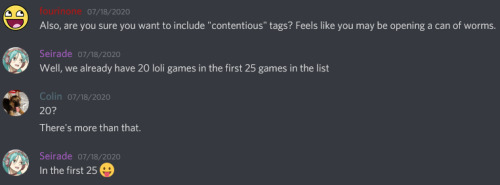
The issue here isn’t just the fictional childporn (though distributing that to people on it’s own is also awful and illegal in most of the world, including the U.S.), it’s that at least one of the childporn games that comes with Flashpoint includes the voice of *an actual child* who was underage at the time of recording. A real child whose voice has been edited by a pedophile (Zone) to sound like she’s engaging in sex. The game is Toph Beifong Interactive Animation. Here is Flashpoint’s Game Master List as proof it’s included there (it can be searched with ctrl+f).
https://archive.ph/7zJHh
Even if you believe “normal lolicon” content is legal in the U.S. (it isn’t), editing an actual child’s voice into your childporn animation definitely isn’t legal. There’s been cases of pedophiles getting in trouble for editing normal photos of kids into pornographic photos, there’s no reason to believe that editing a kid’s voice into simulated childporn would be legal. (For anyone who wants to defend Zone’s actions, would you allow him to record your own child and put them into a porno, so old men can jack off to your child’s voice? No sane parent would agree to this.)
To reiterate, everyone who has downloaded Flashpoint Ultimate has downloaded illegal simulated childporn that involves the voice of an actual child, and there is no warning about it on the Flashpoint website. Even in Infinity there’s a download link to this cp.
The thing that loli defenders always purposefully ignore is, how do they know the shit they jack off to isn’t just traced from actual cp or edited from real children’s voices? For all anyone knows Flashpoint might have loads of other porn animations involving real children.
Normal people in the Discord have brought up that they don’t want the illegal simulated cp shit included in Flashpoint, but they get shot down by the pro-pedophilia people who run the project.








Bluemaxima wants to preserve simulated childporn. Note that he resides in Australia where simulated childporn is explicitly illegal. He has also removed several games from Flashpoint before (such as Nitrome games) because he doesn’t want to get in trouble with the law due to piracy. So why is he willing to break the law when it comes to distributing simulated childporn, but draws the line at piracy? Aren’t Nitrome games also pArT oF hIsToRy?

Note that this blog is not bringing bad publicity onto an archival project. This is Bluemaxima bringing bad publicity onto the project himself, by being so desperate to keep simulated childporn that he breaks his own country’s laws in order to shove toddler rape games and similar shit into Flashpoint. He could easily have removed the simulated cp from Flashpoint, but he wanted it in there with no warning to people downloading the program.
The point about “preservation” is absolute bullshit since Flashpoint already deletes content and keeps it from being preserved for such simple reasons as the author requesting it.
Question why a man would respect copyright law, but be willing to break laws against simulated childporn? Maybe it has less to do with preservation, and more to do with what makes his dick hard?
Bonus creepiness, adults in the Flashpoint Discord advising a child (unless it’s a 20 year old with terrible spelling who still lives with his parents, which is unlikely) on how to download illegal porn games and hide them from his parents:

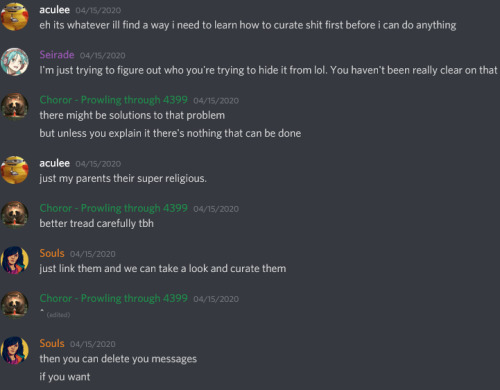


Literal Discord groomers.
Would you want these people to teach your kid how to hide potentially illegal porn from you? Wonder what his parents would think if they knew he used a program containing downloads to dozens of child rape animations?

17 notes
·
View notes
Text
“LET PEOPLE DRAW WHAT THEY WANT!!!111!1” That’s cool Ben but are we talking about self insert ship art or child porn bc there’s a fucking difference.
27K notes
·
View notes
Text
stop commissioning pedophiles, stop following pedophiles, stop reblogging pedophiles. i don’t care how “good” their art is, you’re actively encouraging their existence, survival, and beliefs. let them fucking starve.
14K notes
·
View notes
Note
do you have any receipts about mike inel? I’ve tried searching both tumblr and google but nothing comes up :/
Not a lot of NSFW is showing up on tumblr period, but I’m not the one to go to for this. I also cannot find receipts on him easily but I know I could if I wanted to. But he is a well-known pedophile who has made numerous famous animations of the characters from Gumball, nearly ALL of which involve incest and underage characters. Also if you dig deeper on Google and turn off safe search you will find a LOT trust me. Dig a little deeper if you want evidence or find a blog that specializes in these kind of documentations of creeps. There’s a lot of them with good info
19 notes
·
View notes
Text
Lolicon puts real kids in porn game
Please signal boost this.
There's a lolicon game named Unteralterbach, which contains porn and sex scenes of drawings based on real kids, the game is currently being sold on itch.io, please email them about this and get them to stop selling this game, and do the same if you find it sold or distributed anywhere else.

Was going to post the picture (which was safe for work, by the way) but it might be too risky, so we will just list the names of the children featured in the game, and the game characters based on them as proof (info taken from under the spoiler in the image above):
Laura B = Laura Belanova, Mara Green = Mara Grünzeug, Emma Tiger Schweiger = Emily Geiger, Guttenberg-Tötcher = Schlechtenthal-Zwillinge, Julianna Rose Mauriello = Stephanie, Johanna Papabernds Tochter = Kim Hartmann, Hailey Webcam Mödchen = Henrike Fuchs, ? = Nele Büttner.
10 notes
·
View notes
Text
The Comic Book Legal Defense Fund
Gonna respond to some bullshit articles from the CBLDF, written by Maren Williams, that are spreading misinformation (note, this blog is in fact anti-censorship as long as it's not pedophilia, we only object to childporn, us dissing the CBLDF does not mean we want things like Jeff Smith's Bone pulled from libraries):
http://cbldf.org/2014/06/cnn-spectacularly-fails-to-understand-manga-and-anime/
http://cbldf.org/2015/01/censorship-2014-manga-and-anime-blamed-for-crime/
As Twitter user @zoid9000 pointed out, at least one of those blurred-out covers that was too much for CNN’s delicate cameras actually wasn’t pornographic at all.
The twitter link no longer works, but it was talking about Dolls Fall 2. Here’s pics from inside it (censored by us):


Yeah, how dare CNN call a fanservice snuff porn comic with little girls getting beat up until they piss themselves pornographic!!! WEEB OUTRAGE!!
In regards to the cover itself, how the hell did you fail to notice it has naked child ass on it? (again, censored by us)

That’s not innocent nudity, this is a fanservice comic, so it’s meant to arouse.
The artist decided to give her a ridiculously short skirt and have her ass be bare for titillating reasons, maybe that’s why CNN censored it?
Ripley gives no consideration to free expression rights and seems unaware that his rhetoric could be ripped right from Fredric Wertham’s anti-comics campaign that led to the Comics Code Authority.
Except there’s a difference between outright childporn and violent media. It’s ridiculous to compare the two, the violent equivalent to lolicon porn would be drawn snuff porn, not fucking Tales From the Crypt (which isn’t porn).
Ignoring the fact that manga and anime cover every genre and interest under the sun
Maybe he ignores it because the report isn’t about your weeb hobby but about drawn childporn.
Ripley focuses only on a relatively minor subset and suggests that it will remain legal not because it’s free expression but because “anime animation and manga comics are a multi-billion dollar industry with political and lobbying power.”
Childporn is quite an industry in Japan, considering 6 year old real life junior idol erotica can bring in millions of yen:
https://supercalloutfragilistic.tumblr.com/post/713000317675061248/anime-fans-lie-about-documentary-exposing
Ripley soon proceeds to leading questions, asking politician Masatada Tsuchiya: “Are you concerned that this animated child porn could lead to criminal behavior?” (Shades of Fredric Wertham!)
Way to strawman him, why not bring in Godwin’s Law and call him literally Hitler while you’re at it.
Later in the report Ripley talks to Shihoko Fujiwara, a representative of the anti-child-trafficking group Lighthouse. She brings up another crime that can supposedly be blamed on manga: “a case where a predator used a cartoon to convince a child sex abuse is normal.” In the examples cited by both Tsuchiya and Fujiwara, of course, horrific crimes were committed and should absolutely be prosecuted — but no one could seriously suggest that either of the them would have been prevented if only the perpetrators hadn’t owned manga.
Uh, except Shihoko is not just seriously suggesting that, she’s stating so definitely, and as she works with abused Japanese children she assuredly knows more about the correlation between lolicon and childrape than you.
Ripley does briefly talk to Japan Cartoonists Association lobbyist Ken Akamatsu, himself the creator of the popular manga series Love Hina and Negima! Magister Negi Magi, who points out in vain that “manga doesn’t involve actual children so there are no actual victims”
Maybe his statement is in vain because it’s so fucking stupid? Nobody is claiming that there’s actual victims in the drawings, they’re claiming that fiction influences reality.
and that "there’s no scientific evidence” that manga and anime actually cause people to commit crimes"
This is more along the lines of what people actually argue, but the writer is also ignoring that "there’s [seemingly] no scientific evidence” that drawn childporn doesn’t inflame predatory urges in pedophiles. It clearly did in the case Shihoko talks about and this case:
https://supercalloutfragilistic.tumblr.com/post/712997246347706368/proof-drawn-childporn-incites-men-to-commit-real
Youth Healthy Development Ordinance, does restrict the sale of manga deemed "unhealthy” for minors. When Imōto Paradise! 2 received that designation in May, Amazon also removed the digital manga from its Kindle store even though it wasn’t obligated to do so by law.
What’s with those quotes around “unhealthy”? Is this spokesperson of the CBLDF seriously implying it’s healthy for minors to read childporn with incest? Like is this seriously implying Underage Sister Incest Paradise 2 should be sold to minors?
4 notes
·
View notes
Text
“Being able to tell the difference between fiction and reality” is kinda… not the point. At all.
It’s a lousy argument that completely misses the point entirely.
Cultivation theory, at it’s baseline, doesn’t say that consuming, say, violent media makes you wanna kill or hurt people. What cultivation theory IS is saying “the proliferation of excessive violent media can influence how the people who consume that media perceive about the world” ie a person with already violent tendencies might be more likely to act on those violent tendencies because, due to the sheer glut of violent media, violence might seem more acceptable than it actually is culturally.
And this shit is subconscious, you can’t say you’re not affected by it because “you know the difference between fiction and reality”, because often time you don’t actively register that it IS influencing you.
Or, in the case of many ads, you do know it’s trying to influence you and you put up guard walls - but that burger on screen DOES look delicious and the Burger King is only down the road so why not grab something to eat?
The decline of sharks due to Jaws is people perceiving the sharks as inherently dangerous to human and, thus, to keep people safe, need to be culled.
The rise of the KKK in the late 1910′s and early 20′s was due to Birth of a Nation portraying the KKK as sympathetic and cool.
The decline of the KKK in the 40s can be attributed to their mocking portrayal Superman radio serials.
This shit all matters.
This shit is all people being influenced by fiction even if they can acknowledge that fiction isn’t reality.
18K notes
·
View notes
Note
Second link no longer works, archive:
https://web.archive.org/web/20140311205846/https://www.buzzle.com/articles/negative-influences-of-media.html
Here’s another good article about fiction:
https://www.bostonglobe.com/ideas/2012/04/28/why-fiction-good-for-you-how-fiction-changes-your-world/nubDy1P3viDj2PuwGwb3KO/story.html
Quoting some of it:
This research consistently shows that fiction does mold us. The more deeply we are cast under a story’s spell, the more potent its influence. In fact, fiction seems to be more effective at changing beliefs than nonfiction, which is designed to persuade through argument and evidence. Studies show that when we read nonfiction, we read with our shields up. We are critical and skeptical. But when we are absorbed in a story, we drop our intellectual guard. We are moved emotionally, and this seems to make us rubbery and easy to shape.
But perhaps the most impressive finding is just how fiction shapes us: mainly for the better, not for the worse. Fiction enhances our ability to understand other people; it promotes a deep morality that cuts across religious and political creeds. More peculiarly, fiction’s happy endings seem to warp our sense of reality. They make us believe in a lie: that the world is more just than it actually is. But believing that lie has important effects for society — and it may even help explain why humans tell stories in the first place.
Moreover, it’s clear that these stories really can change our views. As the psychologist Raymond Mar writes, “Researchers have repeatedly found that reader attitudes shift to become more congruent with the ideas expressed in a [fictional] narrative.” For example, studies reliably show that when we watch a TV show that treats gay families nonjudgmentally (say, “Modern Family”), our own views on homosexuality are likely to move in the same nonjudgmental direction. History, too, reveals fiction’s ability to change our values at the societal level, for better and worse. For example, Harriet Beecher Stowe’s “Uncle Tom’s Cabin” helped bring about the Civil War by convincing huge numbers of Americans that blacks are people, and that enslaving them is a mortal sin. On the other hand, the 1915 film “The Birth of a Nation” inflamed racist sentiments and helped resurrect an all but defunct KKK.
So those who are concerned about the messages in fiction — whether they are conservative or progressive — have a point. Fiction is dangerous because it has the power to modify the principles of individuals and whole societies.
For a long time literary critics and philosophers have argued, along with the novelist George Eliot, that one of fiction’s main jobs is to “enlarge men’s sympathies.” Recent lab work suggests they are right. The psychologists Mar and Keith Oatley tested the idea that entering fiction’s simulated social worlds enhances our ability to connect with actual human beings. They found that heavy fiction readers outperformed heavy nonfiction readers on tests of empathy, even after they controlled for the possibility that people who already had high empathy might naturally gravitate to fiction. As Oatley puts it, fiction serves the function of “making the world a better place by improving interpersonal understanding.”
Follow-up studies have reached similar conclusions. For example, one study showed that small children (age 4-6) who were exposed to a large number of children’s books and films had a significantly stronger ability to read the mental and emotional states of other people. Similarly, Washington & Lee psychologist Dan Johnson recently had people read a short story that was specifically written to induce compassion in the reader. He wanted to see not only if fiction increased empathy, but whether it would lead to actual helping behavior. Johnson found that the more absorbed subjects were in the story, the more empathy they felt, and the more empathy they felt, the more likely the subjects were to help when the experimenter “accidentally” dropped a handful of pens — highly absorbed readers were twice as likely to help out. “In conclusion,” Johnson writes, “it appears that ‘curling up with a good book’ may do more than provide relaxation and entertainment. Reading narrative fiction allows one to learn about our social world and as a result fosters empathic growth and prosocial behavior.”
Similarly, novelists such as Leo Tolstoy and John Gardner have contended that fiction is morally beneficial, and here, too, research is bearing them out. While fiction often dwells on lewdness, depravity, and simple selfishness, storytellers virtually always put us in a position to judge wrongdoing, and we do so with gusto. As the Brandeis literary scholar William Flesch argues, fiction all over the world is strongly dominated by the theme of poetic justice. Generally speaking, goodness is endorsed and rewarded and badness is condemned and punished. Stories — from modern films to ancient fairy tales — steep us all in the same powerful norms and values. True, antiheroes, from Milton’s Satan to Tony Soprano, captivate us, but bad guys are almost never allowed to live happily ever after. And fiction generally teaches us that it is profitable to be good.
Take a study of television viewers by the Austrian psychologist Marcus Appel. Appel points out that, for a society to function properly, people have to believe in justice. They have to believe that there are rewards for doing right and punishments for doing wrong. And, indeed, people generally do believe that life punishes the vicious and rewards the virtuous. But one class of people appear to believe these things in particular: those who consume a lot of fiction.
In Appel’s study, people who mainly watched drama and comedy on TV — as opposed to heavy viewers of news programs and documentaries — had substantially stronger “just-world” beliefs. Appel concludes that fiction, by constantly exposing us to the theme of poetic justice, may be partly responsible for the sense that the world is, on the whole, a just place.
This is despite the fact, as Appel puts it, “that this is patently not the case.” As people who watch the news know very well, bad things happen to good people all the time, and most crimes go unpunished. In other words, fiction seems to teach us to see the world through rose-colored lenses. And the fact that we see the world that way seems to be an important part of what makes human societies work.
Our survey respondents reacted to the characters as though they were real people: They admired the protagonists, disliked the antagonists, felt happy when the good guys succeeded, and felt sad or angry when they were threatened. By simulating a world where antisocial behavior is strongly condemned and punished, these novels were promoting ancient human values. And from these books, and from fiction more broadly, readers learn by association that if they are more like the protagonists, they’ll be more likely to live happily ever after.
Fiction is often treated like a mere frill in human life, if not something worse. But the emerging science of story suggests that fiction is good for more than kicks. By enhancing empathy, fiction reduces social friction. At the same time, story exerts a kind of magnetic force, drawing us together around common values. In other words, most fiction, even the trashy stuff, appears to be in the public interest after all.
…and another:
https://web.archive.org/web/20160213205630/https://www.nytimes.com/2012/03/18/opinion/sunday/the-neuroscience-of-your-brain-on-fiction.html?_r=1
Quotes:
Brain scans are revealing what happens in our heads when we read a detailed description, an evocative metaphor or an emotional exchange between characters. Stories, this research is showing, stimulate the brain and even change how we act in life.
In a 2006 study published in the journal NeuroImage, researchers in Spain asked participants to read words with strong odor associations, along with neutral words, while their brains were being scanned by a functional magnetic resonance imaging (fMRI) machine. When subjects looked at the Spanish words for “perfume” and “coffee,” their primary olfactory cortex lit up; when they saw the words that mean “chair” and “key,” this region remained dark. The way the brain handles metaphors has also received extensive study; some scientists have contended that figures of speech like “a rough day” are so familiar that they are treated simply as words and no more. Last month, however, a team of researchers from Emory University reported in Brain & Language that when subjects in their laboratory read a metaphor involving texture, the sensory cortex, responsible for perceiving texture through touch, became active. Metaphors like “The singer had a velvet voice” and “He had leathery hands” roused the sensory cortex, while phrases matched for meaning, like “The singer had a pleasing voice” and “He had strong hands,” did not.
Researchers have discovered that words describing motion also stimulate regions of the brain distinct from language-processing areas. In a study led by the cognitive scientist Véronique Boulenger, of the Laboratory of Language Dynamics in France, the brains of participants were scanned as they read sentences like “John grasped the object” and “Pablo kicked the ball.” The scans revealed activity in the motor cortex, which coordinates the body’s movements. What’s more, this activity was concentrated in one part of the motor cortex when the movement described was arm-related and in another part when the movement concerned the leg.
The brain, it seems, does not make much of a distinction between reading about an experience and encountering it in real life; in each case, the same neurological regions are stimulated. Keith Oatley, an emeritus professor of cognitive psychology at the University of Toronto (and a published novelist), has proposed that reading produces a vivid simulation of reality, one that “runs on minds of readers just as computer simulations run on computers.” Fiction — with its redolent details, imaginative metaphors and attentive descriptions of people and their actions — offers an especially rich replica. Indeed, in one respect novels go beyond simulating reality to give readers an experience unavailable off the page: the opportunity to enter fully into other people’s thoughts and feelings.
The novel, of course, is an unequaled medium for the exploration of human social and emotional life. And there is evidence that just as the brain responds to depictions of smells and textures and movements as if they were the real thing, so it treats the interactions among fictional characters as something like real-life social encounters.
Fiction, Dr. Oatley notes, “is a particularly useful simulation because negotiating the social world effectively is extremely tricky, requiring us to weigh up myriad interacting instances of cause and effect. Just as computer simulations can help us get to grips with complex problems such as flying a plane or forecasting the weather, so novels, stories and dramas can help us understand the complexities of social life.”
Reading great literature, it has long been averred, enlarges and improves us as human beings. Brain science shows this claim is truer than we imagined.
hii!!!!!!! do you know abt posts/articles/etc related to internalizing fiction? have a good day love !!
Hello baby!
Sorry for not making an immediate response but I want tomake sure I got you some reliable information. At NYU, I am a digital mediacommunications major so we closely observe all forms of media.
So as content creators we can prevent ourselvesfrom creating harmful media.
So as content consumers, we can discern what isharmful media and how to filter what is reliable/healthy information/content.
So here I’ve provided someimportant links where you can find more information about this subject and learn more about the state of current literature on the matter.
This short journal highlights theimpact of media on adolescents and children. This is important because earlycognitive psychosocial development before the age of 21 shapesthe way an individual uses and responds to media.
http://www.ncbi.nlm.nih.gov/pmc/articles/PMC2792691/
This article discusses the negativeinfluences of media and elements of how media can be harmful to us in thedigital age. This includes blind imitation, a compromised moral code (right andwrong dilemma), and blurred lines/confusion between fantasy and fiction.
http://www.buzzle.com/articles/negative-influences-of-media.html
This book details the power of media to shape socialrealities and the effects of media on behavior, attitude, beliefs, and culture. They also provide stats on the affect ofmedia on households, etc.
https://books.google.com/books?hl=en&lr=&id=KnQXQOP5uoMC&oi=fnd&pg=PA69&dq=media+affects+reality&ots=SXvUpShviO&sig=FLJSjxHBN72JPhouttvjsCSvJvE#v=onepage&q=media%20affects%20reality&f=false
This is an official nursing website that states that thereis CURRENTLY NOT A DEBATE in the MEDICAL COMMUNITY ABOUT THE EFFECT OF media ONPEOPLE. The public health community, especially the psychiatric andpsychological community, unanimously believe that the effects of media (allforms) is potent in affecting a person’s perception of reality.
http://www.truthaboutnursing.org/faq/media_affects_thinking.html
CONCLUSION: The medical, media, and social scientists are ata consensus.
FICTION DOES AFFECT REALITY.
I hope that these were helpful to you doll.
If you need anymore links are interested in one aspectspecifically, let me know. I’ll see if I can dig up something from my scholarlyreadings.
Tchau! :D
130 notes
·
View notes
Text
“Fiction doesn’t affect reality!!!”
Well okay then explain why you are consuming and creating media and fanart and having shipping discourse and harassing minors over cartoons…
366 notes
·
View notes
Text
ARTISTS. DO NOT. CONDONE. REAL LIFE. FELONIES. BY DRAWING. FICTIONAL. SITUATIONS.
34K notes
·
View notes
Text
CBR responds to us and defends pedophilia
The writer is Reuben Baron:
https://www.cbr.com/cartoon-fandom-has-a-puritanism-problem/
https://web.archive.org/web/20230317032552/https://www.cbr.com/cartoon-fandom-has-a-puritanism-problem/
The article CBR is responding to seems to have gotten a lot of their info from here (for example, we were to our knowledge the first to report about Zone working on Ok Ko and Arin Hanson collaborating with Shadman) without crediting us (which is fine, credit is not needed):
https://medium.com/@brazyintheday/kids-tv-has-a-porn-problem-84592d9514fc
https://archive.is/HtXfE
Just noting that because this makes CBR’s response by association partly an article attacking our blog.
Rebecca Sugar is first taken to task, along with her partner Ian Jones-Quartey, for collaborating with Trigger, one of the best anime studios in the world.
Calling Trigger one of the best anime studios in the world is like calling Shadman one of the best loli artists on Newgrounds. Who cares if they’re one of the best (which is only CBR’s opinion) in some niche when they still produce depraved chomo shit.
There is nothing "creepy" about the studio's specific contributions to Steven Universe and OK K.O.
What sort of excuse is this? That doesn't matter. The issue is people who jack off to children working in children's media and gaining a fanbase among impressionable kids. You wouldn’t let a zoophile care for your dog (even if they said they were only into fiction), you wouldn’t let a necrophile care for your dead (even if they said they were only into fiction) , so why would you let a pedophile care for your kids (even if they said they were only into fiction)?
Regarding the Amphibia drama, industry professionals posted comments like this:
https://painted-starlight.tumblr.com/post/186960194938/uuuh-what-the-fuck-is-going-on-with-the-amphibia

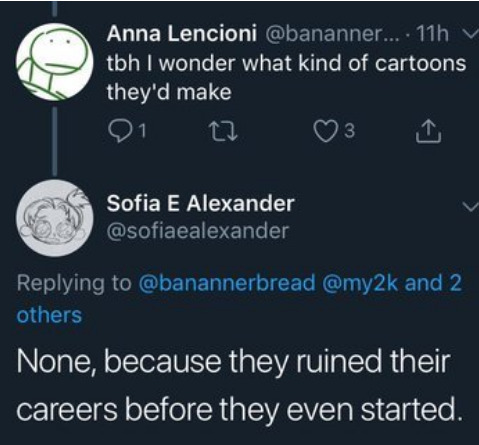
The above is exactly why almost nobody except anonymous whistleblowers dare to protest pedophilia in the industry. Regardless of if you believe the Amphibia art is okay, this attitude is why people like John K are allowed to be a creepy for so long without being called out. Normal people are afraid of speaking up due to the risk of being blacklisted by the pedo approving clique running the industry.
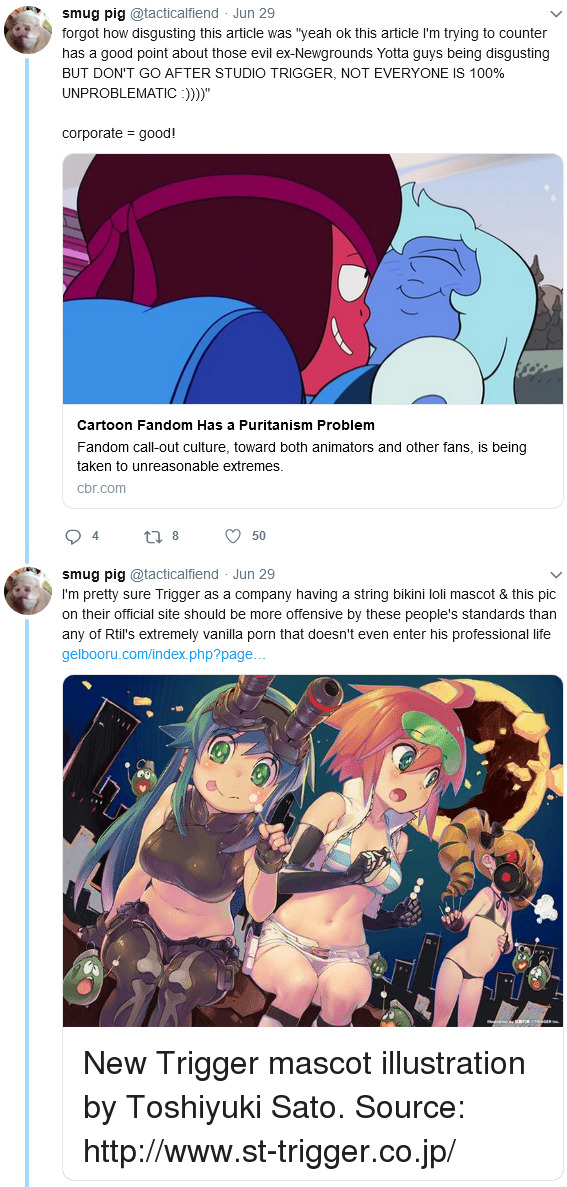


Like with AO3, this is another case of leftist hypocrisy.
https://supercalloutfragilistic.tumblr.com/post/713381087333744640/what-the-fuck-knew-they-hosted-porn-based-on
In CBR’s article, edgy Newgrounds animators are deemed “problematic” and “callout worthy” for their pedophilia, while equally pedophilic things the left wing author likes are deemed excusable.



CBR says:
It feels like no coincidence that the creators, both professionals and in fan communities, most virulently targeted and often harassed by the fandom puritans tend to be women and/or minorities. Rebecca Sugar is non-binary, Ian Jones-Quartey is black, Hannah Ayoubi is an Arab-American woman.
What a joke of a statement, our Shadman callout got something like over 10,000 notes (guess by puritans guilty of harassing him lmao). Proof cishet males get just as much “harassment “.
This blog is centrist, by the way.

8 notes
·
View notes
Text
Steven Universe
Just reporting about Raven Molisee being a pedo, since that hasn’t been covered yet by the blog. Credit to EZ PZ on youtube: [Trigger Warning: Slurs, ableism and queerphobia] https://www.youtube.com/watch?v=QLxVO018r4w&t=2602s and https://www.youtube.com/watch?v=wlzl0gUdb3I&t=1912s
Because despite Rebecca Sugar drawing childporn,

and despite a second animator on the show drawing childporn, who I later discovered was Raven Molisee [...],
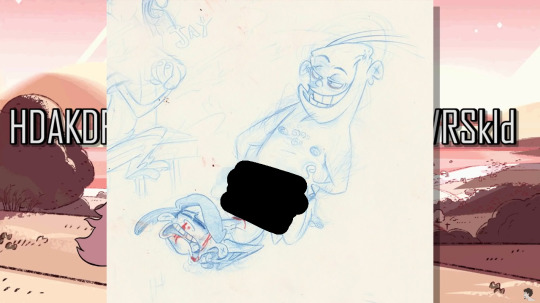
Note: This doesn’t look to be Eddy, but Eddy’s adult brother raping child Double D so hard his ass bleeds.
despite a third animator, who was considered for the show, turning out to be grooming little girls for sex,

despite Ian Jones-Quartey liking borderline loli art on tumblr,

despite him hiring the borderline childporn artist Zone to work on Ok Ko,

despite how two children fusing is an obvious metaphor for sex,

despite all of this, [the fans will claim that] there are no pedophiles working on Steven Universe and there are no pedophilic themes in the show.
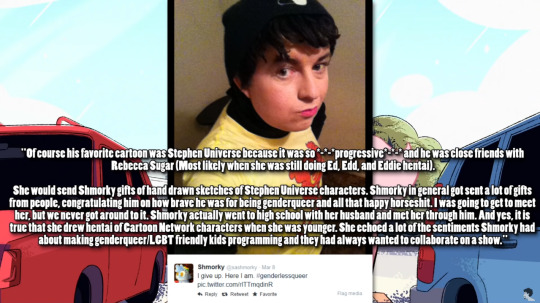

Note: Shmorky is okay with being referred to by he / him pronouns.
Molisee also wrote and storyboarded the episode Frybo, where the child Steven runs around naked.
14 notes
·
View notes
